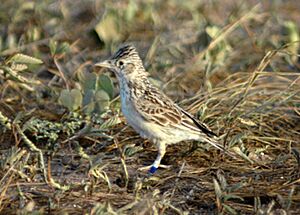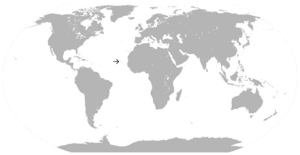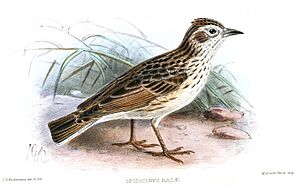Raso lark facts for kids
Quick facts for kids Raso lark |
|
|---|---|
 |
|
| Conservation status | |
| Scientific classification | |
| Genus: |
Alauda
|
| Species: |
razae
|
 |
|
| Synonyms | |
|
|
The Raso lark (Alauda razae) is a small passerine bird. It lives only on a tiny island called Raso in the Cape Verde Islands. This bird is critically endangered, meaning it is at high risk of disappearing forever. It lives in very dry places. Scientists do not know much about this bird because its home is so far away.
Contents
About the Raso Lark
What is a Raso Lark?
Raso larks are small birds, usually between 14 and 18 centimeters long. That is about the length of a pencil. Adult male larks are usually bigger than the females. Their bodies have short black and brown stripes. Their chest area is lighter in color. They also have a crest of feathers on their head that can stand up.
The Raso lark has a strong, thick beak. Male larks have longer beaks than females. A Raso lark is considered an adult when it gets a reddish-brown color between its ears and tail. It also develops a special pattern on its head and back. When they fly, you can see their short tail and wide wings. The edges of their wings and tail are white.
Where Do Raso Larks Live?
The Raso lark lives only on Raso islet. This is a small island in the Cape Verde group. Long ago, during the last ice age, Raso was connected to other islands. Scientists have found old bones that show Raso larks once lived on Santa Luzia, São Vicente, and Santo Antão islands too.
However, when people started living on these islands in the 1400s, many animals disappeared. Raso islet has no fresh water and no people have ever lived there. This has likely helped the Raso lark survive until now.
The island is mostly rocky desert. It has some sandy areas in the west. Most Raso larks live on flat plains with volcanic soil. They like to be near small patches of plants along dry riverbeds. These are the places where they find food and build their nests. Less than half of Raso island is good for them to breed.
The dry island often has droughts, which means very little rain. This makes the plains dry. The larks then have to move around the island to find food. Because water is scarce, only small areas have plants for them. The Raso lark is very sensitive to droughts. This is one reason why it is an endangered bird.
Life and Habits of the Raso Lark
How Raso Larks Find Food
Raso larks dig in the ground to find food. They look for insect larvae and small bulbs from plants called nutsedges. Both male and female larks also eat grass seeds and insects. These insects include butterflies, moths, and grasshoppers.
During dry seasons, food and water are hard to find. The larks get what they need by eating the bulbs of nutsedges. These bulbs are like small onions. It was once thought that males ate more bulbs because their beaks are bigger. Males' beaks are about 20% larger than females'.
However, new studies show that males eat more bulbs because they control the best feeding spots. Males protect these areas, which often have many burrows with food. They even keep females away from these spots. Females can dig for bulbs just as well as males. But females spend less time digging. They spend more time looking for food on the surface.
Because of this, females often die faster. They have to find food for themselves and also sit on their eggs. This means they have less time to look for danger. They also get more stressed about finding food. During times when there is little food, females are more likely to starve.
Raso Lark Reproduction and Life Cycle
Raso larks breed when it rains. Their breeding is hard to predict because it depends on when the rain comes. The male bird tries to attract a female by singing softly. He raises his chest and hops up and down with his wings open.
After mating, both the male and female collect dry grass to build a nest. The male protects the nesting area. The female finds a safe spot to build the nest.
The female Raso lark usually lays one to three eggs at a time. She lays them about a day apart. The eggs hatch after about 15 days. While the female is sitting on the eggs, she takes breaks to find food.
The number of Raso larks changes quickly depending on the rain. During droughts, their numbers can become very low. There are also more male larks than females. This makes it harder for the birds to have many babies.
Dangers to Raso Larks
The Raso lark faces dangers from predators. These include the Cape Verde giant gecko and birds like the lesser Cape Verde kestrel, brown-necked raven, and Cape Verde barn owl. The Cape Verde giant gecko weighs about 100 grams. It eats young birds and eggs before they hatch.
Raso larks are also in danger from animals that might accidentally come to the island. Fishermen or other visitors could bring cats, dogs, or rats. If these animals got onto Raso island, they could cause a lot of harm.
Protecting the Raso Lark
The Raso lark population is very small. It changes from about 200 to 1,000 birds. There are also about two males for every female. These reasons make the Raso lark critically endangered.
The birds do not have many babies that survive. This is likely because the Cape Verde giant gecko eats their chicks and eggs. Luckily, there are no rats or wild cats on Raso island right now. The island is also a protected area. But if even one of these animals accidentally got there, it could be very bad for the larks.
Scientists have suggested a plan to help the Raso lark. They want to start a second group of larks on another island called Santa Luzia. This island does not have the giant gecko. This would give the Raso lark a better chance to survive.
Images for kids







